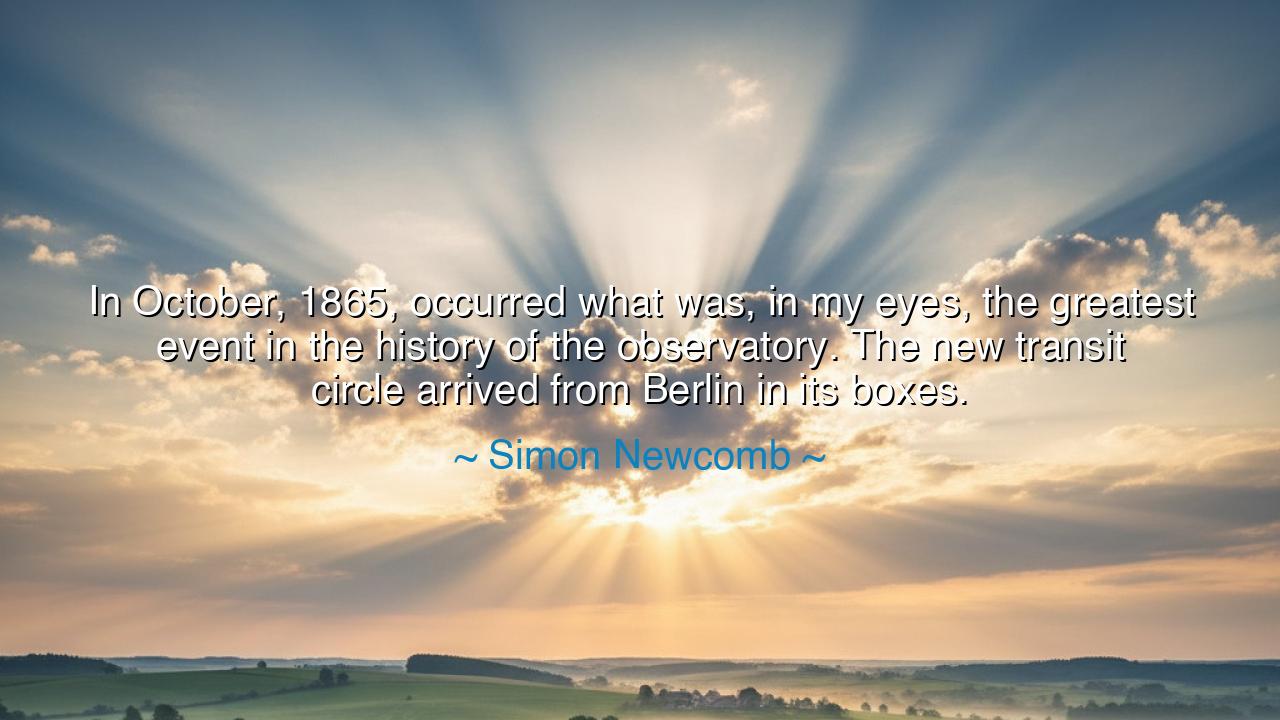
In October, 1865, occurred what was, in my eyes, the greatest
In October, 1865, occurred what was, in my eyes, the greatest event in the history of the observatory. The new transit circle arrived from Berlin in its boxes.






The words of Simon Newcomb — “In October, 1865, occurred what was, in my eyes, the greatest event in the history of the observatory. The new transit circle arrived from Berlin in its boxes.” — seem, at first glance, to describe a simple moment: the arrival of an instrument. Yet within these words lies a deeper revelation — a hymn to the spirit of discovery, to the quiet ecstasy of the scientist who beholds not the glory of conquest, but the birth of precision, order, and truth. In this humble remembrance, Newcomb reveals to us the essence of human progress: that greatness often arrives not in thunder or flame, but in wooden crates, carried by patient hands, ready to open new windows to the stars.
To understand the weight of this moment, one must know the man who spoke it. Simon Newcomb, one of the foremost astronomers and mathematicians of the nineteenth century, devoted his life to understanding the heavens — not through myth or poetry, but through measurement and reason. The transit circle he speaks of was no mere tool; it was a sacred instrument of alignment, used to record the precise crossing of stars across the meridian, allowing humankind to know its position in the vastness of the universe. For Newcomb, the arrival of this device from Berlin was not just the shipment of metal and glass — it was the arrival of clarity, the dawn of an era in which the mysteries of the cosmos could be charted with unprecedented accuracy.
Think of that moment in October of 1865 — the wooden boxes resting upon the observatory floor, the air cool with the breath of autumn, and the hearts of scholars alive with anticipation. Within those crates lay not only an instrument, but the promise of order in the heavens. Each screw and lens, each carefully calibrated circle, was born of centuries of striving — the labor of artisans and thinkers who had refused to be content with shadows and guesses. In the gleam of that new instrument, Newcomb saw the culmination of humanity’s oldest dream: to measure the infinite, to make sense of the stars that once ruled the fates of kings. His joy was not in possession, but in participation — in being a link in the chain of those who seek knowledge not for power, but for truth.
This reverence for precision is the mark of the true scientist, and indeed, of the true artist. For both know that greatness lies not in the grand gesture, but in the perfect line, the exact measure, the patient refinement of one’s craft. Newcomb’s exultation at the arrival of the transit circle reminds us that every civilization is built upon such moments — moments when humanity receives a new instrument, a new way of seeing, and with it, the courage to ask better questions. The telescope, the printing press, the microscope, the computer — all have come to us, as the transit circle came to Newcomb, in quiet boxes that conceal revolutions.
We see this same spirit in the tale of Galileo, who raised his telescope toward the night sky and saw, for the first time, the moons of Jupiter. That simple tube of glass and wood — so crude by modern standards — shattered an entire world order. It was not a crown or a sword that altered history, but an instrument of vision, handled by a man willing to look beyond dogma. Newcomb’s joy at the arrival of the transit circle echoes Galileo’s awe before the stars: both men understood that progress is born not of arrogance, but of humility — the humility to measure before believing, to listen before declaring.
And yet, there is something profoundly human in Newcomb’s excitement — a childlike wonder that even in the age of reason, the soul can still feel reverence. For what is science if not a continuation of worship — not of gods, but of truth itself? When Newcomb called the arrival of that instrument “the greatest event” in the observatory’s history, he was not exalting machinery, but the union of human curiosity and divine order. In the turning of the transit circle’s gears, he heard the music of the cosmos — precise, eternal, harmonious.
So let this story remind us, O seekers of wisdom, that greatness often comes disguised as simplicity. A humble instrument, a quiet revelation, a single moment of insight — these are the seeds from which the vast gardens of knowledge grow. Do not wait for thunder to move you; rejoice instead in the arrival of small beginnings. Like Newcomb, see the sacred in the scientific, and find wonder not only in stars, but in the tools that help you reach them. For in every age, the true event worth celebrating is not the triumph of man over nature, but the deepening of his understanding within it. Thus, when next a gift of learning arrives before you — even in plain boxes — open it as Newcomb did: with awe, gratitude, and the eternal fire of curiosity.






AAdministratorAdministrator
Welcome, honored guests. Please leave a comment, we will respond soon